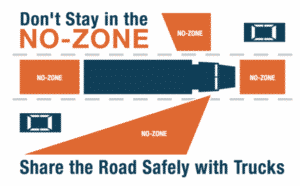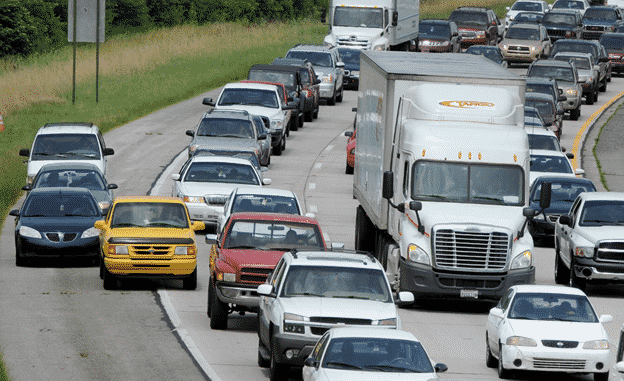When you start your commute back to work again, here are 10 ways to stay safe around 18-wheelers.
The Covid-19 pandemic not only changed the way Americans work, but it also changed where they work from. Before the pandemic, only 1 in 5 people who say their job responsibilities can be done from home actually worked from home all or most of the time. That number increased to 71% by December of 2020. With more people working from home, fewer drivers are on the road commuting. But with the rollout of the vaccine, that’s about to change.
As more people start working from the office and commuting to work again, more accidents are inevitable. It is always important to keep a safe watch for other vehicles on the road, but 18-wheelers and other large trucks pose unique risks to drivers on their commute. Here are ten ways to stay safe around large trucks when commuting to work.
1. Use a hands-free device.
Georgia law requires drivers using a cell phone to use a hands-free device. It also prohibits drivers from texting or using video on their phones while driving. Using a hands-free device keeps your attention on the road in front of you instead of on the phone in your hand. That way, a driver can react more quickly to an 18-wheeler changing lanes or slowing down dramatically.
2. Keep a safe distance between your car and trucks on the road.
It is always important to keep a safe distance between the front of your car and the back of the vehicle in front of you. But with trucks, it is almost more important to ensure there is a safe distance between your rear bumper and the truck behind you. This is because trucks take longer to brake than passenger cars. So, if a truck is tailgating your car, move over and let it pass.
3. Stay out of the truck’s blind spot.
Because of the size of their trailer, trucks have more blind spots than a passenger car, and the blind spots are bigger. From the chart below, you can see that 3 or 4 cars can be driving alongside a tractor-trailer without the truck driver being able to see them. When commuting around trucks, do not drive in the “no-zones.”

4. Let 18-wheelers pass you.
We have all been stuck behind an 18-wheeler driving slower than we want to drive. But we have all seen speeding truck drivers on the highway too. If an 18-wheeler is trying to pass you, let it. Trying to stay in front of an 18-wheeler trying to pass is a recipe for disaster and increases your chances of getting into a truck accident.
5. Watch out for wide turns.
Trucks take wider turns than regular cars to make way for the trailers they tow. If you see an 18-wheeler with its blinker on ahead of a turn, slow down and do not try to pass. The trailer may leave the truck’s lane during the turn and cause an accident if you are in the way.
6. Be wary of tire blowouts and tires in the roadway.
With 18 wheels come 18 tires. The life of tires on a semi-truck varies dramatically. But just like a car’s tires, a truck’s tires must be changed based on the mileage they have driven. When driving near trucks, it is essential to recognize that a tire blowout may happen at any time. After all, you do not know how long that truck has driven on those sets of tires – or whether there are one or two tires much older than the others.
Tires in the roadway can cause unprepared motorists to swerve out of the way. Often, cars swerving to avoid a tire hit other cars or spin out into the median or off the road.
7. Wear your seat belt!
Not only is it safer to wear a seat belt, but it is illegal not to. Truck accidents can be more deadly than accidents involving two passenger cars simply because of the size of the trucks and the weight they carry. The CDC reports that seat belts reduce the risk of death by 45% and serious injury by 50% for drivers and front-seat passengers. Also, a driver not wearing a seatbelt is 30 times more likely to be ejected from the vehicle during an accident. WEAR YOUR SEAT BELT!!!
8. Obey the speed limit.
For the last two decades, speeding has been a factor in about one-third of all motor vehicle deaths. Speed limits are set to account for several factors, including the roadway condition, the ease (or lack thereof) of cars entering or exiting the road, and typical traffic patterns. Driving over the speed limit increases the chance of each of those factors causing an accident. Because of the size of tractor-trailers, their drivers’ reaction times are slower. If a driver approaches them going at a speed higher than the speed limit, they may not have time to react to avoid the accident themselves.
9. If you must pass an 18-wheeler, do so quickly and on the left side.
Different trucks have different blind spots. As we already discussed, it is crucial to stay out of a truck’s blind spot so that you are not merged into. But it is also important not to remain side-by-side with a truck for too long. That way, you reduce the chance of a merging accident dramatically. If you must pass an 18-wheeler, do so under the speed limit, but as swiftly as you can safely do so. Also, stay to their left since visibility is better for truck drivers on the driver’s side. Also, in Georgia, trucks are not permitted to drive in the left-most lane on certain roads. Passing in the left-most lane lessens the likelihood that a truck will merge into your lane.
10. Watch out for trucks entering and leaving the highway.
Big trucks make slow turns. The reason being, they pull a lot of weight behind them. If you see a truck up ahead that is about to enter or leave the roadway, slow down. Chances are their turn will take much longer than you think. At a slower speed, you can react to avoid an 18-wheeler who is slowly pulling out into the roadway or even have time to stop if you must.
For more information about how Rafi Law Firm investigates truck accidents, click here.
For information on how to determine whether the truck was at fault for your accident, click here.
